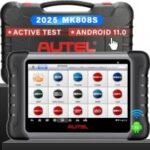An OBDII reader can be a valuable tool for checking the health of your catalytic converter. By understanding how to use it and interpret the data, you can gain insights into potential issues and ensure your vehicle runs efficiently. This guide outlines a standardized driving cycle, initially developed by General Motors, that can help activate all necessary diagnostic monitors, including the catalytic converter monitor, enabling a comprehensive check using your OBDII reader.
Understanding the OBDII Driving Cycle for Catalyst Testing
A complete On-Board Diagnostics II (OBDII) driving cycle triggers diagnostics across various vehicle systems, taking less than fifteen minutes to complete. This cycle enables your OBDII reader to gather crucial data for analysis. The following steps detail the GM driving cycle, which effectively covers many vehicle types, including Jeeps, ensuring a thorough check of your catalytic converter:
Cold Start: The Foundation of the Diagnostic Process
Begin with a cold start, meaning your engine coolant temperature is below 50°C (122°F) and within 6°C (11°F) of the ambient air temperature. Avoid turning the key on prematurely, as this could interfere with the heated oxygen sensor diagnostic. This cold start initiates essential diagnostics for components like the O2 heater.
Idle: Engaging Key System Checks
Let the engine idle for two and a half minutes with both the air conditioner and rear defroster on. Maximizing the electrical load enhances the effectiveness of this stage, testing components like the O2 heater, passive air system, purge system, and identifying potential misfires. This phase also determines if the system has achieved closed loop, allowing for fuel trim analysis.
Acceleration and Steady Speed: Evaluating Performance Under Load
Turn off all accessories and accelerate at half throttle to 88 km/hr (55 mph). This tests misfire, fuel trim, and purge flow diagnostics. Maintain this speed steadily for 3 minutes, allowing the system to assess O2 response, air intrusion, EGR, purge, misfire, and fuel trim functions.
Deceleration: Monitoring Emissions Control
Decelerate without using the brakes or clutch, allowing the vehicle to coast down to 32 km/hr (20 mph). This phase focuses on EGR, purge, and fuel trim diagnostics, crucial for emissions control.
Second Acceleration and Steady Speed: The Catalyst Monitor Phase
Accelerate again at 3/4 throttle to 88-96 km/hr (55-60 mph), replicating the diagnostics from the first acceleration phase. Then, hold a steady speed of 88 km/hr (55 mph) for five minutes. This crucial step activates the catalyst monitor. Note that a marginal catalyst or recent battery disconnect might require up to five complete driving cycles to accurately assess the catalyst’s condition.
Final Deceleration: Completing the Cycle
Repeat the deceleration process, coasting down without braking or clutching, to finalize the diagnostic cycle. This mirrors the first deceleration phase and provides further data for analysis.
Conclusion: Using Your OBDII Reader for Catalyst Health
Following this driving cycle allows your OBDII reader to collect the necessary data to assess your catalytic converter’s health. By understanding the steps and their corresponding diagnostic functions, you can pinpoint potential issues. Remember to consult your OBDII reader’s manual for specific instructions on retrieving and interpreting the diagnostic trouble codes (DTCs) related to the catalytic converter. A properly functioning catalytic converter is vital for emissions control and overall vehicle performance. Using an OBDII reader and this driving cycle helps you maintain a healthy and efficient vehicle.

